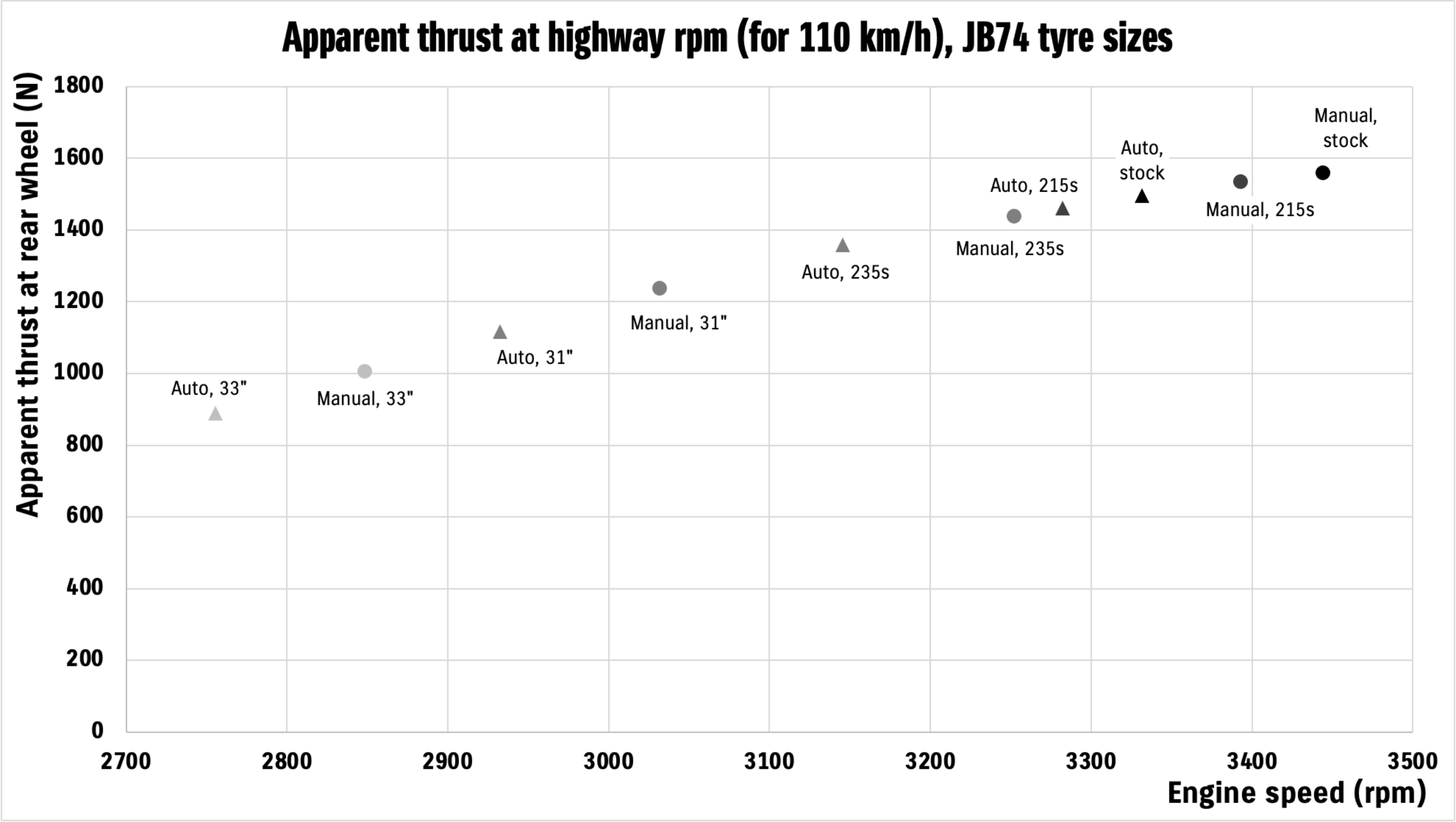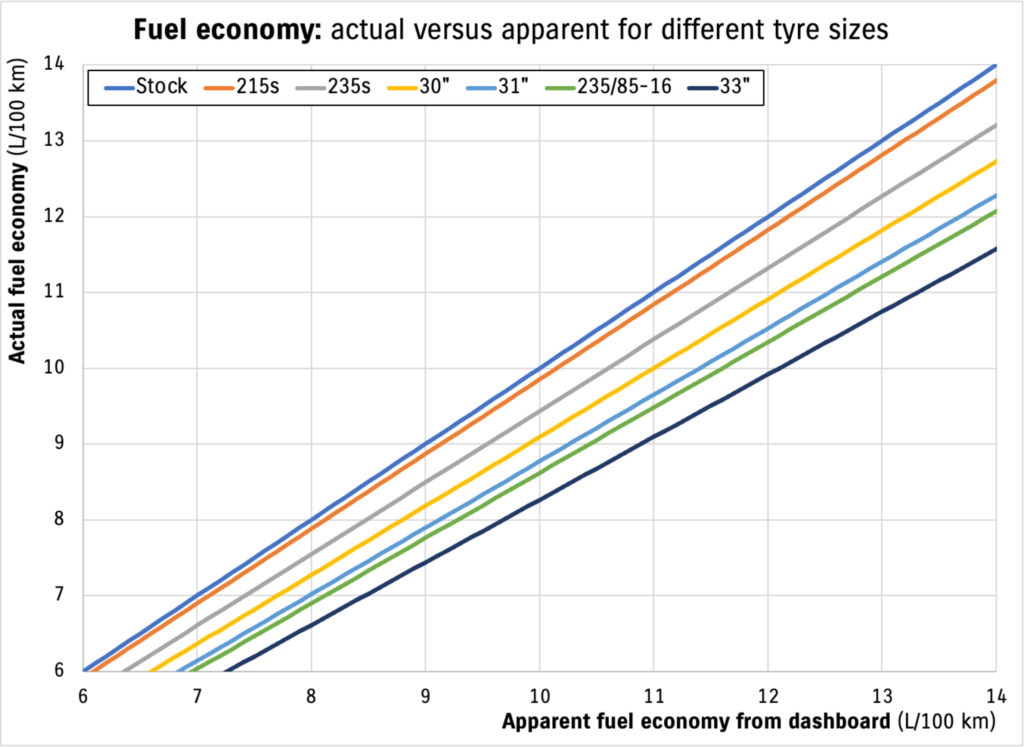Fuel economy
One of the areas that you see people ask endless questions is about the Jimny’s fuel economy. Some people think it isn’t great (in the context of being a little car with a small engine); other people think it’s fantastic (for a 4wd of its capabilities). In addition, the default fuel consumption is displayed as km/L on the dashboard. For many owners this then adds some confusion.
Standard economy
Interestingly, Suzuki don’t publish all of their economy figures except for the automatic which is captured in the Green Vehicle Guide. They also nominally provide the same economy between the 3 and the 5 door Jimnys. Since they also publish combined CO2 emissions, one can back-calculate the slight difference in economy between the different doors. The reported CO2 emissions actually suggest a slightly better economy figure for 3 door manuals (6.3 L/100 km instead of 6.4) when compared to the reported economy directly.
| Model | Combined economy (L/100km; g CO2/km) | Urban economy (L/100km; g CO2/km) | Highway economy (L/100km; g CO2/km) |
|---|---|---|---|
| 3 door manual | 6.4; 146 | ||
| 3 door automatic | 6.9; 158 | 8.2; 185 | 6.1; 143 |
| 5 door manual | 6.4; 148 | ||
| 5 door automatic | 6.9; 161 |
Basically, the autos will get about 8% worse fuel economy than the manuals, and 5 doors will get slightly (~2%) worse economy than a 3 door, at least based on the published figures.
However, we all know that cars rarely get their published figures, in the real world.
Real world economy
This is all based on keeping a car standard, but from my experience with my manual car, when it was standard I got very high 6L/100km, so closer to what is specified for the automatic, for a mix of urban and free-flowing 80-100 km/h zones. Standard automatics, based on various commentary in owners groups, get more like mid 7L/100km standard. 5 doors roughly get 1L/100km worse than a 3 door due to their extra weight, though this is accentuated in stop-start city traffic and much less pronounced with consistent running speeds.
The model of Jimny and its transmission is just one factor that affects fuel economy. Fuel economy will also vary for any car that is modified away from standard.
Factors that effect economy away from a standard car
I’ve tried to break down these factors so we can come up with some rough rules of thumb to get an idea about fuel economy variability and to help people understand what downsides certain modifications or otherwise might have.
Different types of driving
As alluded to above, different types of driving will affect economy and potentially considerably. However, unlike many larger cars (with larger engines), the Jimny struggles with high levels of aerodynamic load so full highway runs at 100-120 km/h will see much worse economy than at 80-90. On the very open road sitting at 110 km/h I will see 20-30% worse fuel economy, knocking it back even to 100 is a reasonable decrease and the sweet spot seems to be closer to 95ish. Your best will probably be constant speed running around this speed to slightly lower.
People then make the assumption that it is the high revs that result in the poorer economy at full highway speeds, but the reality is the engine is geared about as well as it can be for the standard levels of power. In that link I explore a hypothetical longer top gear; ultimately, it can’t really be any longer and make the car get better economy. We’ll touch on this in a bit but it means that modifications that drop your engine speed at highway speeds will not see an improvement in fuel economy.
What is hurting you on the highway is the aerodynamics, and there’s not really much you can do about that since you bought something with the blunt aerodynamics of a brick.
Ultimately you can think of it like this:
- Constant speed, 80 km/h zone = best economy you’ll get
- City driving will be 10-20% worse than that
- Highway driving 90-100 km/h will be 10-20% worse than your best
- 100+ km/h will be another 10% worse than that
- 115+ km/h will be another 10% worse again
Standard with a manual that might mean you go from 6.8-6.9 L/100 km in nice relaxed slightly mixed driving to mid 7L/100km driving around town, high 7s to 8s on slower highway runs and 8-9L/100 km if you’re sitting on the Australian highway limit: and, just to note, that’s before you account for transmission differences or the heavier weight of a 5 door car.
A huge factor here when you are trying to understand if your fuel economy is acceptable is that people are not very good at characterising their fuel economy in terms of the exact type of driving they do. Many people will say they do highway driving, but it’s more at commuting time so it is free flowing but also not at the full open road highway speeds that would reduce economy. Alternatively, one person’s stop-start traffic might be something you regard as free-flowing or vice-versa. Bear this in mind when you are comparing against what other people say.
Wheel and tyre changes
A huge thing that effects fuel economy is changing wheels and/or tyres. There’s a few factors at play here:
- Almost all tyre changes, let alone wheel changes, will result in a heavier wheel/tyre combination.
This affects predominantly stop-start traffic due to the higher rotational inertia. - Most tyres people go for are designed for more offroad use.
This gives them worse rolling resistance characteristics (so you have more inherent drag) but also their chunkier tread pattern will have worse aerodynamics. Offroad biased tyres are also often noisier; that extra noise is energy that, ultimately, is coming from fuel you are burning: it is one part (but not all!) of the rolling resistance difference - Finally, a tyre change is likely to change the overall size of the tyre which changes the car’s gearing, reducing economy. Even tyres in the standard size can vary in their overall size, let alone once you go to (generally) larger tyres.
Tyre size economy correction
I’ve split this out into a sub-heading purely because it can be a large factor and it will reduce fuel economy. A change to a 215/75-15 tyre is only a 1.5% change in gearing so doesn’t change fuel economy too much; by the time you’re at a 235/75-15 you’ve changed gearing 6% and there is a corresponding change to fuel economy. Larger than that and without reduction gearing the economy gets worse and worse. The actual reason for this is not just the longer gearing, but also because for a given speed the engine has less torque available, so you need to apply more throttle (and burn more fuel) to make up for this.

In addition to this change though is you also need to understand correcting fuel economy for tyre size differences. Since the car doesn’t know that your tyre size has increased, it doesn’t realise you have travelled as far as you have. Thus the reported fuel economy by the car or calculated using fillup volume & odometer reading will be off by the difference in the tyre size compared to standard. The amount you have to correct depends on the change in tyre size:
- 215/75-15 is a 1.5% change
- 235/75-15, 205R16 or other 29″ tyre is a 6% change
- 30″ tyre is a 10% change
- 31″ tyres present a 14% change
- 235/85-16 is a 16% change
- 33″ tyres are a 21% change

To use this graph, locate what your dashboard is saying along the bottom axis, slide up till you hit the line that corresponds to your tyre size and then go over to the left to read off what your actual fuel economy is.
For smaller tyre size changes such as putting on a 215/75-15, any reduction in apparent economy is basically just down to the tyre characteristics, but once you get to larger sizes you do need to take into account the size corrections. For example, if your dashboard says 7.5L/100 km and you’re on 215s, you’re actually getting 7.4 L/100 km. However, if you’re running a 31″ tyre and the dash reports 8.5 L/100 km then you’re also getting 7.4 L/100km.
Personally, I just take 215s as the dash reads, for 235s knock off about half a litre/100 km and 31s knock off around 1L/100 km from what it reads as a mental correction factor.
Suspension changes
Suspension changes by themselves won’t really hugely affect fuel economy, though some people report differently. From people I know with higher suspension but stock tyres, generally they’ve ended up with about the same change. The difference is mostly down to people driving the car harder with upgraded suspension, or the suspension being fitted with upgraded tyres that will change fuel economy, as discussed above.
Theoretically there will be a slight change in aerodynamics with the car being taller & a bit more space underneath to develop vortices but it’ll be a lower order effect than other things like tyre changes etc.
Bullbars
Now this is something which will absolutely change economy. Bullbars add weight, which will adversely affect fuel economy in stop-start traffic as you have more weight to accelerate. In addition, bullbars will be less aerodynamic and so will make fuel economy worse on the highway, as well.
How much is really difficult to say. I probably saw a highish fraction of a L/100 km when I fitted my ARB bullbar but the car was otherwise standard, maybe 0.2-0.3 L/100 km in mixed driving.
Roof racks and awnings
This can actually change fuel economy a lot, especially on the highway: mostly this will be due to added aerodynamic drag. Some roof platforms can weigh a lot, not far off the added weight of many bullbars, so obviously that will also change your fuel economy around town.
Awnings and things hanging off the side of the car will have a small penalty on the highway; at the ultimate end of the spectrum here if you do end up wanting to do something like a roof top tent, ignoring aspects of the roof load limit aside, then that might be responsible for 1-2 L/100 km worse economy. Large swags tied up on the roof can do the same.
Towing
A final area that will change fuel consumption is towing with the Jimny, and this is actually surprisingly hard to quantify. What it varies on will depend on a few factors:
- Type of towing you’re doing
Long highway runs will depend a lot on the geometry of the trailer (see below) but around town it’s much more around weight. Being mindful of the cost of speeding up again after slowing down will make a big difference in such situations though. - The geometry of the trailer
If your trailer is a lot taller or wider than the Jimny (and most are) then you’ll find much worse economy. People towing teardrop caravans can report economy as bad as 15L/100 km if they’re doing higher speed highway runs with largeish caravans close to the weight of the car. Towing something smaller, like a camper pod trailer, seems to add 1-2 L/100 km but usually people also doing this have knocked off some speed which helps a lot. - Your experience towing
The people who seem to have the best economy are people who are experienced at towing. They’re usually better at anticipating traffic and hills to optimise the economy for a particular journey, and also more likely to pick something Jimny appropriate. Trying to drive just how you would without a trailer, while towing a large trailer, is a recipe for much worse fuel economy.
Wrapping it up: what sort of consumption should I expect?
Fuel economy display and units
A final thing that people
